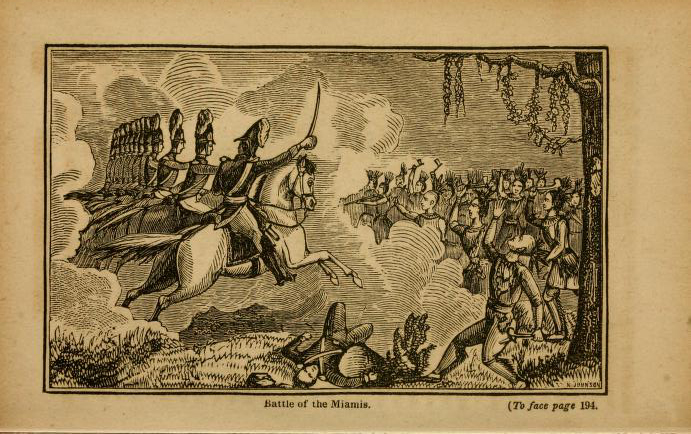Pennsylvania Information
-
January 1, 2023 post by Heartfelt History on Facebook:
"Anthony Wayne, son of Isaac, looming up before us to day, was born January 1, 1745, and grew to young manhood upon his father's plantation of over five hundred acres, and about the tannery, traces of which still remain. He had the benefit of a somewhat desultory education received from an uncle living in the country, and he spent two years in Philadelphia at the academy out of which arose the University of Pennsylvania. The bent of his mind even in boyhood was to mathematics rather than to literature. At the time of the French and Indian war, wherein his father had served as a captain, he was at an age when startling events make their strongest and most lasting impressions, and in his sport he discarded balls and marbles to construct intrenchments and engage in mimic battles. At the academy he studied surveying and determined to make that occupation the pursuit of his life.”
From: Anthony Wayne by Samuel Pennypacker, published in 1908
Sources says not in copyright
Image: Major-General Anthony Wayne by James Peale c. 1795, via Wikimedia Commons, public domain
-
January 1, 2023 post by the Sons of the American Revolution - Richard Montgomery Chapter on Facebook:
Today in History
Did you know that Paul Revere, “Mad Anthony” Wayne and Betsy Ross were born on New Year’s Day?
Paul Revere - January 1, 1735
“Mad Anthony” Wayne - January 1, 1745
Betsy Ross - January 1, 1752 -
July 23, 2022 post by General "Mad" Anthony Wayne Organization, Inc no longer on Facebook:
So where, exactly, is General "Mad" Anthony Wayne buried?
Haunted Places in Erie Pa. Mad Anthony Wayne posted Nov 14, 2019 by David DiCola on YouTube
Erie News Now produced a three part series on Haunted Urban Legends in and around Erie Pa. We learned about Revolutionary War soldier Anthony Wayne and how his spirit still haunts Route 322 every New Years Day.
-
October 19, 2018 post by The History Center on Facebook:
Following the dedication of our first American fort on October 22, 1794, the namesake of our city, General Anthony Wayne, never again graced the land of three rivers. Wayne died from complications of gout on December 15, 1796 and was buried at Fort Presque Isle (present-day Erie, Pennsylvania). His son Isaac Wayne disinterred the body in 1809, relocating it to the family plot at St. David’s Episcopal Church in Radnor, Pennsylvania. These decayed remnants are from the original coffin that held General Wayne’s body while buried at Fort Presque Isle. Come and glimpse these objects and much more during Fright Night!
The History Center
-
1902 - Mad Anthony's Two Graves
Article from Aug 27, 1902 Fort Wayne Weekly Sentinel (Fort Wayne, Indiana) 1902, "mad anthony" wayne, Grave1902 - Mad Anthony's Two GravesFort Wayne Weekly Sentinel, Fort Wayne, Indiana, Wednesday, August 27, 1902, Page 3.
MAD ANTHONY'S TWO GRAVES
BONES OF FAMOUS SOLDIER FOR WHOM FORT WAYNE IS NAMED REST AT RADNOR; HIS FLESH AT ERIE.
-
History Tidbits: The Ghostly Afterlife of “Mad” Anthony Wayne
by Logan Knight
Genealogy Gems: News from the Allen County Public Library at Fort Wayne, No. 235, September 30, 2023
**************************************
Outside, the weather is turning crisp, the leaves are beginning to change color, and the days are getting shorter. When that happens, it seems inevitable that our thoughts begin to turn in a more eerie direction. In this part of the country, perhaps no figure dominates the landscape quite like “Mad” Anthony Wayne. Wayne’s life is well known, but what do you know about his death? Did you know that he was buried in not one but two graves?
Certainly, the character of “Mad” Anthony Wayne seems to be an odd choice for a ghostly afterlife. His actual life was dramatic enough. A towering figure of the American Revolution, Wayne was noted for his aggression upon the battlefield. When asked if he could take the fortress of Stony Point, New York, Wayne replied “Issue the order, and I’ll storm Hell!” The General was not called on to do that, but he did serve ably throughout the war. This was not the end of his service though. Wayne would command the Legion of the United States and defeat the Northwest Indian Confederacy, opening the modern American Midwest to settlement.
Shortly after his great victory at Fallen Timbers (1794), Wayne took ill. A lifetime of hard living had taken its toll on the man. He suffered from gout, a disease that sprouted up from too much alcohol and red meat. Wayne shuffled off this mortal coil on December 15, 1796 aged just fifty-one. He was buried underneath the floor, next to the flagpole, of a fort blockhouse in modern day Erie, Pennsylvania. That seemed to be the end of old “Mad” Anthony, yet that was not the case.
For thirteen years, his body rested underneath that fort. Such an ignominious grave seemed inappropriate for a prominent war hero. In 1809, his children, Isaac and Margaretta, decided to return his body home. Isaac journeyed to Fort Presque Isle and had his father’s body disinterred. The remains of “Mad Anthony” were uniquely well preserved for being underground for over a decade.
Isaac Wayne realized he could not transport his father’s body back home to stately Waynesborough Manor across the rugged paths that passed for roads at the time. He solved the problem in a distinctly grisly manner. He had “Mad” Anthony boiled in a large iron pot, separating the remaining tissue from the bones. The parts were then separated. Embalming had only just arrived and was not available. While this method seems gruesome to us today, this form of preservation was not uncommon, especially for bodies that were located far away from their eventual burying place. Onlookers made the scene more ghoulish by snipping off locks of the General’s hair. One particular witness grabbed a boot off of Wayne’s foot. He then had a companion boot made for the other foot and proceeded to wear them until they fell apart.
Isaac loaded up his father’s bones for the long journey across Pennsylvania. Unfortunately, it seems the casket carrying the precious load was not fully secure. Along the rough wagon roads, bumps and knocks were the order of the day. It seems that some bones were knocked out of the wagon on the long trip home.
They say that every January 1, Wayne’s birthday, you can see his ghost riding on horseback between Erie and Philadelphia, looking for his lost bones. His route supposedly traces U.S. Route 322 that runs southwest through the Keystone State. People have seen him going both east and west along the road which would make sense. After all, if he didn’t find his bones the first time, then another sweep makes sense.
When he is not riding the highways, Wayne’s bones today rest at Old Saint David’s Church Cemetery, just outside Philadelphia. The fleshy bits remained underneath what is now called the Wayne Blockhouse back in Erie, Pennsylvania. They still keep the iron boiling pot at the Hagen History Center, not too far from the blockhouse. So, if you happen to be out late, keep an eye out. Who knows what you might see? Happy Halloween!
-
December 30, 2023 post by Tredyffrin Easttown Historical Society on Facebook:
The Strange Story of Anthony Wayne’s Graves, by Joyce DeYoung
Easttown is fortunate to have preserved Historic Waynesborough, birthplace and home of Major General “Mad” Anthony Wayne. He was a dedicated, courageous Revolutionary War officer, but the macabre story of what happened to his earthly remains has overshadowed his war exploits.
In late 1796, 51 years old and burdened with gout and war injuries, Wayne lay dying at Fort Presque Isle, now site of the city of Erie. On December 15th he died and was interred according to his wishes, at the base of the garrison’s flagpole. This portrait dates from about the time of his death.
There the general rested for 13 years until the summer of 1809. That year his son, Isaac Wayne, at the behest of his sister, traveled from Waynesborough to his burial site. Isaac wanted to disinter his father and rebury him in the family plot at St David’s Churchyard in Radnor. Expecting to find only a skeleton when the grave was opened, those present were greatly surprised to find a well-preserved corpse, the only decomposition being the lower leg which had been afflicted with gout.
How to move a fleshed corpse by horse and cart 380 miles over primitive roads in summer, roughly along the route of US 322, a journey that would take several weeks? Surely decomposition would begin. Isaac called for Dr. John Wallace, the same physician Wayne had requested to attend him. A decision was made to render the corpse to remove the flesh from bone so the clean skeleton could be transported. Wayne’s clothing was cut away as was his ponytail. Then Dr. Wallace dismembered the corpse. The pieces were put into a large cauldron of boiling water. After the flesh sloughed off, the bones were cleaned and put into an ossuary box for travel back to Easttown. The remaining parts of Anthony Wayne along with the dismembering implements were put back in the coffin and reinterred in the original grave. The bones were buried, as the family wanted, in St. David’s Churchyard. The marker is shown nearby.
By 1853 the long abandoned fort was leveled. The location of the grave was lost until 1878 during construction of the Pennsylvania Soldiers and Sailors Home. Again his coffin was dug up. This time little but the lid and dissection tools remained. A replica of the original blockhouse was constructed on the spot in 1880 and once again what little remained of Anthony Wayne was buried in a tomb inside. The blockhouse (shown here) and grave can be visited on the grounds of the Soldiers and Sailors Home near the waterfront in Erie.
The general's wife preceded him in death by several years. When he died, his life and death information were engraved onto her tombstone. Therefore he has three grave markers for two graves. However, not ALL of him rests in a grave; this photograph shows his ponytail as displayed in a glass case at Historic Waynesborough.
Maybe even that’s not all. There is a legend that some bones were lost on the trip from Erie, and that every January 1, Wayne’s birthday, his ghost and that of his horse Nancy ride between Radnor and Erie looking for his lost bones.
HAPPY NEW YEAR!
Sources:
History Matters: The Strange Story of Anthony Wayne’s Graves, by Joyce DeYoung
Friends of Historic Waynesborough. Special thanks to Eric Williams and Michelle Bradley.
https://www.AmericanRevolution.org/wayne.php, accessed 08/28/2023.
Erie Co. Historical Society, Hagen History Center, https://www.eriehistory.org/.../a-halloween-story-the..., accessed 08/28/2023.
- General Anthony Wayne home at Paoli near Philadelphia, Pennsylvania and tombstone at Old Saint David’s Church Cemetery from the The Library of Congress.
- Waynesborough Home of Revolutionary War’s General “Mad” Anthony Wayne on Philadelphia and The Countryside states
Wayne is buried in two graves. Thirteen years after Wayne’s death and burial in Erie, PA, at the family’s request, his son Isaac brought back the General’s bones for another burial in the family’s plot in Radnor, PA.
- Mad Anthony Wayne’s Bones published October 30, 2014 by Jamestown Settlement & American Revolution Museum at Yorktown blog now on the Internet Archive Wayback Machine states:
There is a strong oral tradition in Pennsylvania that all of Mad Anthony’s bones did not make it back home. As the story goes, the bones had not been properly packed, and many of them were lost on the long overland trek from Erie to Radnor. This circumstance gave rise to one of the best ghost stories about a Revolutionary War hero. Every year on January 1, the General’s birthday, Mad Anthony Wayne goes out searching for his lost bones. His ghost rides along U.S. Route 322 in Pennsylvania, a road that follows the path along which the bones were scattered, and seeks to recover them. Understandably, the General is mad that he is buried in Erie, in Radnor, and at several locations in-between
. - Paoli Battlefield has a short history.
-
October 11, 2023 post by Uncharted Lancasteron Facebook:
Revolutionary War General "Mad Anthony" Wayne has the unique distinction of being the only Pennsylvanian known to have two separate graves, with body parts in both. Legend holds that his ghost rises every New Year's morning to make the 400-mile journey from Valley Forge to Erie along 322, searching for his missing body parts. Learn the full story in this #hauntedLancaster tale. The Ghost of General ‘Mad Anthony’ Wayne and his Missing Bones
-
Sunday, August 4, 2024 shared post by General "Mad" Anthony Wayne Organization, Inc no longer on Facebook:
Interesting moment in history...
Saturday, August 3, 2024 post by Historic Waynesborough on Facebook:
Today, August 3rd, is the 229th anniversary of the signing of the Treaty of Greenville, The Treaty was signed between the United States, represented by Major General Anthony Wayne, and chiefs of the Indian tribes located in the Northwest Territory, including the Wyandot, Delaware, Shawnee, Ottawa, Miami, and other tribes. It ended the Northwest Indian War and opened the Northwest Territory for settlement.
By Anthony Wayne’s side was the Reverend David Jones from the Baptist Church in the Great Valley, in Tredyffrin Township between Valley Forge and Anthony Wayne’s home in Easttown Township. The church was founded in 1711 by Welsh Baptists who came here for religious freedom.
In 1776 Rev. Jones was granted a leave of absence from his church to join the Continental Army and serve as Chaplain to General Anthony Wayne. Nineteen years later he was, again, by then Major General Anthony Wayne’s side.
On a recent tour of the church and cemetery, visitors were told his history in front of Rev. David Jones’ grave. Reverend Jones was an outspoken patriot, his words so vehement; the British put a price on his head. Here he is mentioned in an excerpt from a letter from Anthony Wayne to Benjamin Franklin: “Ticonderoga 29th July 1776Dear Sir: We are so far removed from the sea of Govern’t of the free and independent states of America – and such an Insurmountable Barrier, Albany, between us that not one letter or the least intelligence of anything that’s doing with you can reach us. Through the medium of my Chaplain, David Jones, I hope this will reach you as he has promised to blow out any man’s brains who will attempt to take it from him…”
This anniversary of the Treaty of Greenville we salute another patriot who was there, Reverend David Jones.
***************
Their photograph of a blooming tree shows the extinct in the wild Franklin Tree.
Extinct Franklin Tree Franklinia alatamaha Information
- Franklinia search results at Bartram's Garden Southwest Philadelphia, Pennsylvania. The botanic garden established by the Bartram family in the 1700s has been preserved and was designated a public park by the City of Philadelphia in 1891. It’s a home for horticulture, the first nationally landmarked landscape, and the oldest surviving botanic garden in North America. The Garden is operated by the non-profit John Bartram Association in partnership with the Philadelphia Department of Parks & Recreation.
- Franklin Tree Franklinia alatamaha Extinct in the wild, this unique species is conserved in arboreta and botanical gardens around the world. Arnold Arboretum Harvard University Boston, Massachusetts.
A 281-acre preserve in the heart of Boston, the Arnold Arboretum of Harvard University stewards one of the world’s most comprehensive and best documented collections of temperate woody plants, with particular focus on the floras of eastern North America and eastern Asia.
...In 1765, King George III named Bartram “King’s Botanist in North America,” a position which came with £50 a year. Bartram’s son, William, returned to the area in Georgia to collect seed of the Franklin tree several years later. In 1791, he wrote, “We never saw it any other place, nor have I ever seen it growing wild, in all my travels, from Pennsylvania to Point Coupe, on the banks of the Mississippi.” He brought the seeds back to Philadelphia. His collection of the species was timely; within 50 years, the tree was extinct in the wild. All living Franklin trees—which Bartram named for family friend Benjamin Franklin—are descended from the seeds Bartram collected.
- Franklinia Tree (Franklinia alatamaha) Franklin & Marshall College. The Franklinia tree has only ever been known to grow on the banks of the Altamaha River in southeastern Georgia. In 1765, John Bartram discovered this tree and then in 1773, he collected its seeds to bring back to the Bartram's gardens in Philadelphia where he was successfully able to grow the tree. This tree has been extinct in the wild since 1803, but the cause for its extinction is unknown. This means that all current franklinia trees are derived from the seeds that were collected by Bartram. The franklinia is a petite tree with sweetly fragrant, 5 petaled, white flowers with egg-yolk yellow centers. Its leaves are dark green, long, and thin, and turn shades of orange, red and purple in the fall.
- Franklin Tree Franklinia alatamaha New Georgia Encyclopedia, Georgia Humanities, University of Georgia Press. July 30, 2018 Facebook post: Franklin tree or lost camellia (Franklinia alatamaha) is an unusually beautiful tree, once native only to Georgia, that is also one of the rarest trees in the world. Discovered in the mid-eighteenth century, the Franklin tree was last recorded in the wild by a nurseryman and plant collector in 1803. All known specimens today are in cultivation.


